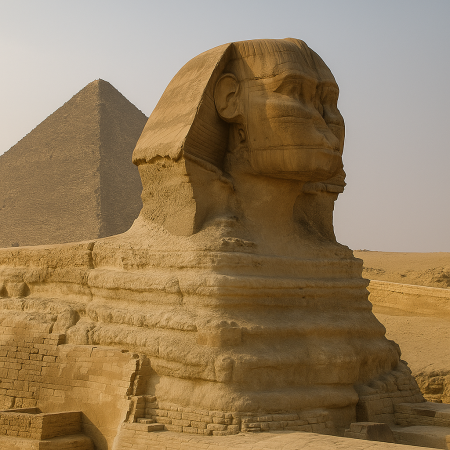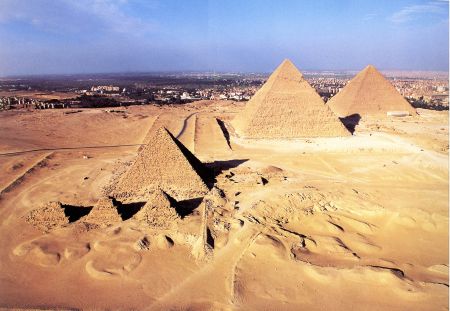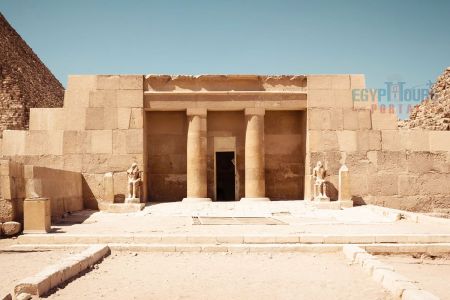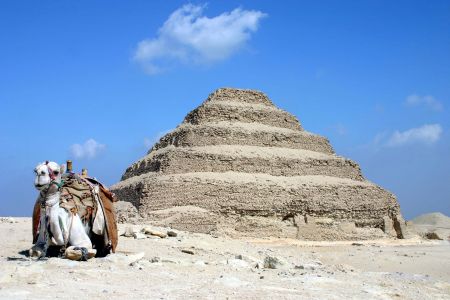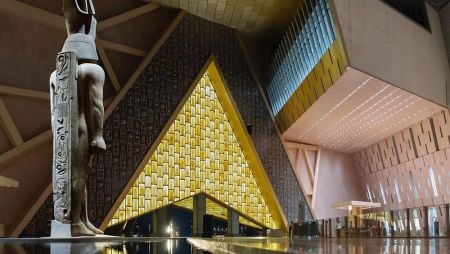the Mysteries of the Great Pyramids of Giza : A Timeless Marvel of Ancient Egypt
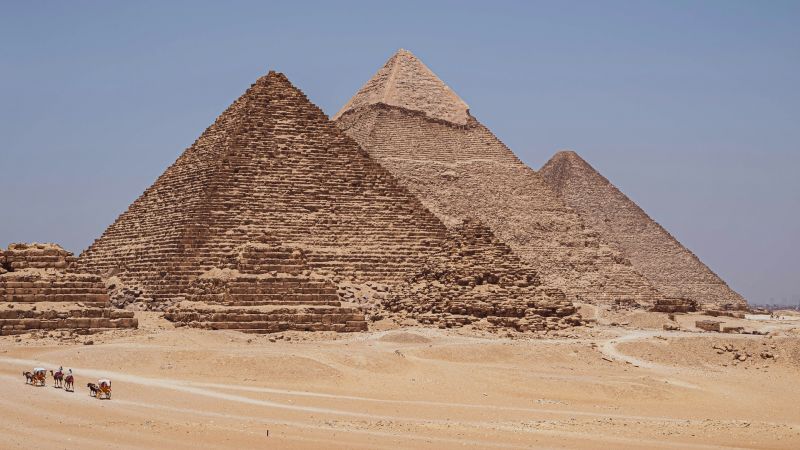
Standing boldly against the golden desert horizon just outside Cairo, the Great Pyramids of Giza continue to captivate the world. These ancient stone structures aren’t just architectural wonders — they are potent emblems of Egypt’s long-lost grandeur. Towering above the sands for over 4,500 years, the Pyramids of Giza include three main pyramids: the Great Pyramid of Khufu (also known as Cheops), the Pyramid of Khafre (Chephren), and the smaller Pyramid of Menkaure (Mykerinos). Alongside them lies the iconic Sphinx, its lion's body and enigmatic human face silently guarding the necropolis.
More than mere tombs, the pyramids are the final resting places of mighty pharaohs who believed they would ascend to the afterlife. Every massive limestone block, perfectly aligned chamber, and hidden shaft whispers of ancient precision and cosmic alignment. These awe-inspiring monuments are the only remaining wonders of the Seven Wonders of the Ancient World — an immortal reminder of what mankind can achieve through faith, science, and sheer will.
Today, the Great Pyramids of Giza remain one of the top tourist attractions in Egypt and globally. They draw millions of travelers, scholars, and spiritual seekers each year, eager to marvel at their scale, decode their secrets, and stand where history began.
The History of the Great Pyramids of Giza: From Vision to Eternity
The Reign of Pharaoh Khufu and the Birth of the Great Pyramid
The Great Pyramid of Khufu, the largest of the trio, was built around 2580–2560 BCE during the Fourth Dynasty of the Old Kingdom. Originally reaching a height of 146.6 meters (481 feet), it held the title of the world’s tallest man-made structure for over 3,800 years. Comprising an estimated 2.3 million blocks of stone, each weighing between 2.5 and 15 tons, the pyramid is a stunning testament to engineering without the use of modern machinery.
Pharaoh Khufu envisioned a monument to preserve his soul and guarantee his divine status in the afterlife. The result was a pyramid so precisely aligned with the cardinal points of the compass that even modern tools would struggle to replicate its accuracy.
Pyramid of Khafre: Guarded by the Great Sphinx
Khafre, Khufu’s son, built the second pyramid at Giza. Though slightly shorter than his father’s, it appears taller due to its elevated location and the remnants of casing stones still clinging to the top. Beside it lies the Great Sphinx — a colossal limestone statue measuring 73 meters long and 20 meters high. Believed to bear Khafre’s likeness, the Sphinx continues to inspire speculation about its age, purpose, and symbolic power.
The Modest Majesty of Menkaure’s Pyramid
Menkaure, Khafre’s successor, constructed the smallest of the three pyramids. Despite its modest size, it is lauded for its refined construction and intricate mortuary temple. Some scholars argue that Menkaure's pyramid reflects a shift in focus toward more religious and philosophical interpretations of kingship rather than sheer size.
Architectural Mastery: The Secrets Behind Pyramid Construction
Engineering Brilliance Without Modern Tools
How the pyramids were constructed remains a topic of debate among Egyptologists. Theories range from massive labor forces using copper tools and sledges to more advanced possibilities involving internal ramps or counterweight systems. What's undeniable is the meticulous alignment with the stars and the Nile River, reflecting not just engineering but cosmological sophistication.
Labor and Logistics: More Than Slaves
Contrary to popular myths, the pyramids were not built by slaves but by well-fed, skilled laborers. Archaeological findings, such as workers’ villages, bread ovens, and medical facilities, reveal a highly organized society that took great pride in contributing to royal tomb construction.
The Interior Chambers: A Labyrinth of Mystery
The Great Pyramid contains three known chambers: the King’s Chamber, the Queen’s Chamber, and an unfinished subterranean chamber. The Grand Gallery, with its soaring corbelled ceilings, leads to the King's Chamber, housing the enigmatic granite sarcophagus. Narrow shafts aligned with celestial bodies suggest the ancient Egyptians believed in a journey beyond the stars.
Treat yourself to comfort and style on Luxury Egypt Tours
Astronomical and Religious Symbolism: The Pyramids as Portals to the Afterlife
Sacred Geometry and Stellar Alignments
The pyramids were more than monumental tombs; they were symbolic gateways. Their precise alignment with the Orion constellation and the North Star reinforces the ancient Egyptian belief that pharaohs would join the gods in the afterlife. The triangular shape itself mirrors the sun’s rays — a pathway to divine ascent.
Sun God Ra and the Solar Boat
Solar mythology dominated ancient Egyptian religion. The Great Pyramid complex includes boat pits where full-sized ships were buried, likely to carry the pharaoh’s soul across the celestial Nile. One such vessel, the Khufu ship, was found in perfect condition and now resides in the nearby Giza Solar Boat Museum.
Visiting the Great Pyramids Today: A Bucket List Journey
How to Get to the Pyramids of Giza from Cairo
Located just 13 kilometers southwest of downtown Cairo, the Giza Plateau is easily accessible by taxi, tour bus, or even rideshare apps. Many visitors choose guided tours for insightful commentary and smoother access, especially during peak tourist season.
Tickets, Hours, and Tips for Travelers
The Pyramids of Giza are open daily, typically from 8 AM to 5 PM (subject to change in summer or Ramadan). Entry tickets allow access to the plateau, with additional fees for entering the pyramids themselves. Be sure to bring water, sun protection, and cash in Egyptian pounds. Hiring a licensed guide is highly recommended.
Best Times to Visit the Pyramids
To avoid the midday heat and crowds, early morning or late afternoon visits are ideal. Winter (October to April) offers the most pleasant weather. Sunset camel rides and early morning hot air balloon tours provide unforgettable perspectives.
Experience Egypt in style with our Best Luxury Nile River Cruise, combining guided sightseeing with first-class cabins and service.
Pyramids in Pop Culture and Modern Influence
Hollywood’s Fascination with Ancient Egypt
The Great Pyramids have inspired countless films, documentaries, books, and conspiracy theories. From Indiana Jones to Stargate, their enigmatic presence adds mystery and grandeur to every narrative.
The Pyramids and the Global Imagination
Whether seen as alien artifacts, energy centers, or divine tombs, the Great Pyramids of Giza continue to spark global curiosity. They've become symbols not just of Egypt but of ancient wisdom, endurance, and human potential.
Conclusion: Why the Great Pyramids of Giza Still Matter
The Great Pyramids of Giza are more than stone structures — they’re timeless beacons of civilization, spirituality, and ingenuity. Standing beneath their shadow, one can't help but feel the enormity of history, the brilliance of ancient minds, and the spiritual legacy etched into every block.
They’re a journey into the past, a pilgrimage for the soul, and a legacy for the future.
Frequently Asked Questions About the Great Pyramids of Giza
What is the best time of year to visit the Great Pyramids of Giza?
The best months to visit are from October to April, when the temperatures are cooler and the weather is ideal for outdoor exploration.
Can you go inside the Great Pyramid of Giza?
Yes, visitors can enter the Great Pyramid for an additional fee. The experience includes climbing narrow shafts and viewing the King's Chamber.
How old are the Great Pyramids of Giza?
The Great Pyramid of Khufu was completed around 2560 BCE, making it over 4,500 years old.
Are the pyramids part of the Seven Wonders of the Ancient World?
Yes, the Great Pyramid is the only surviving structure of the original Seven Wonders of the Ancient World.
What is the mystery behind the Great Sphinx of Giza?
The Sphinx’s origins and symbolism remain debated. Some theories suggest it predates the pyramids, while others link it directly to Pharaoh Khafre.


